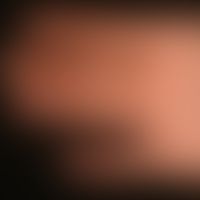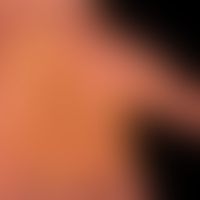Image diagnoses for "Palm", "Plaque (raised surface > 1cm)", "yellow"
25 results with 51 images
Results forPalmPlaque (raised surface > 1cm)yellow

Nevus verrucosus Q82.5
Naevus verrucosus (detailed picture) striped arrangement of yellow-brownish papules and plaques.

Keratosis palmoplantaris diffusa with mutations in KRT 9 Q82.8
Keratosis palmoplantaris diffusa circumscripta: Thick, waxy, yellowish, plate-like horny layer which covers the entire palm of the hand and also the sole of the foot. The mobility of the hands is restricted. Characteristically, the red seam of the affected groin skin shown here separates the infected skin from unaffected field skin.

Psoriasis palmaris et plantaris (overview) L40.3
Psoriasis palmaris: dry keratotic plaque type, chronic flat hyperkeratosis that has led to a considerable restriction of hand movement.

Hand and foot eczema, hyperkeratotic-rhagadiformes L24.9

Bowen's disease D04.9
Bowen's disease: chronically stationary, slowly increasing in area and thickness, sharply defined, now clearly (knot formation), symptom-free, red, rough, sometimes scaly and crusty plaque on the palm of the hand.

Keratosis palmoplantaris diffusa with mutations in KRT 9 Q82.8
Keratosis palmoplantaris diffusa circumscripta: Thick, waxy, yellowish, plate-like horny layer that covers the entire palm of the hand and also the sole of the foot; the mobility of the hands is restricted.

Keratosis palmoplantaris diffusa with mutation in keratin 1 Q82.8
Keratosis extremitatum hereditaria transgrediens et progrediens.

Hand and foot eczema, hyperkeratotic-rhagadiformes L24.9

Psoriasis palmaris et plantaris (plaque type) L40.3
psoriasis palmaris et plantaris (plaque type): chronic inpatient type. deeply drawn hand lines. there is a risk of rhagade formation here. oval encircles the sharp marking zone to the wrist. arrows mark the edges of the psoriatic plaques.

Skabies B86
Scabies: long-term untreated, only moderately itchy scabies, with infestation of the entire integument. eczematous, pyodermic skin lesions on the fingers. remark: clear neglect of the patient

Psoriasis palmaris et plantaris (overview) L40.3
Psoriasis palmo-plantaris. dry keratotic plaque type (only little successful pre-treatment) with sharply limited (typical is the sharp limitation to the field skin of the wrists, distinction to chronic hand eczema). painful rhagades in the skin tension lines (see ball of the hand).

Keratosis palmoplantaris diffusa with mutations in KRT 9 Q82.8
Keratosis palmoplantaris diffusa circumscripta. 2-year-old boy has a chronic, congenital, smooth, evenly distributed, waxy thickened and yellowish discolored plaque formation of both palms. No symptoms. It is an autosomal dominant inherited palmoplantar cornification disorder.

Pustulosis palmaris et plantaris L30.2
Pustulosis palmaris et plantaris: acutely occurring, disseminated, 0.2-0.4 cm large, smooth yellowish pustules next to older, dried brown spots; neither history nor clinical evidence of psoriasis.

Psoriasis (Übersicht) L40.-
Psoriasis palmaris: chronic inpatient plaque psoriasis of the hands with localized, in places striped, keratotic plaques that have been present for years.

Psoriasis palmaris et plantaris (plaque type) L40.3
Psoriasis palmaris et plantaris (plaquet type): For explanations see the following figure.

Keratosis palmoplantaris diffusa with mutation in keratin 1 Q82.8
Keratosis extremitatum hereditaria transgrediens et progrediens

Pustulosis palmaris et plantaris L30.2
Pustulosis palmaris et plantaris: massive (sterile), painful pustulosis of the soles of the feet after a febrile (streptococcal) infection. solitary, also grouped pustules, in places conflated to form larger "pus lakes". associated, pressure-painful arthritis (swelling) of the sternoclavicular joints.

Keratosis palmoplantaris diffusa with mutations in KRT 9 Q82.8
Keratosis palmoplantaris diffusa circumscripta: Thick, waxy, yellowish, plate-like corneal layer, which is sharply separated from the field skin by a red stripe; in the lower right part of the picture the waxy corneal plate had detached a few days ago.

Psoriasis palmaris et plantaris (plaque type) L40.3
psoriasis palmaris et plantaris (plaquet type): palmo-plantar psoriasis known for years. no pre-treatment. extensive, sharply limited erythema. circumscribed partly stripy hyperkeratotic plaques. single deep rhagades.

Pustulosis palmaris et plantaris L30.2
Pustulosis palmaris et plantaris: square: grouped pustules, low collateral erythema. encircled: confluent pustule. pustules: sterile

Psoriasis palmaris et plantaris (plaque type) L40.3
Psoriasis palmaris et plantaris (plaque type): flat palmar erythema; striated keratotic plaques that are loyal to the site.

Psoriasis palmaris et plantaris (overview) L40.3
Psoriasis palmaris et plantaris. dry keratotic plaque type. non pretreated psoriasis palmaris. in a 42-year-old man, these sharply defined, rough, hyperkeratotic plaques, which have existed permanently for months, appear in the area of the right palm.


